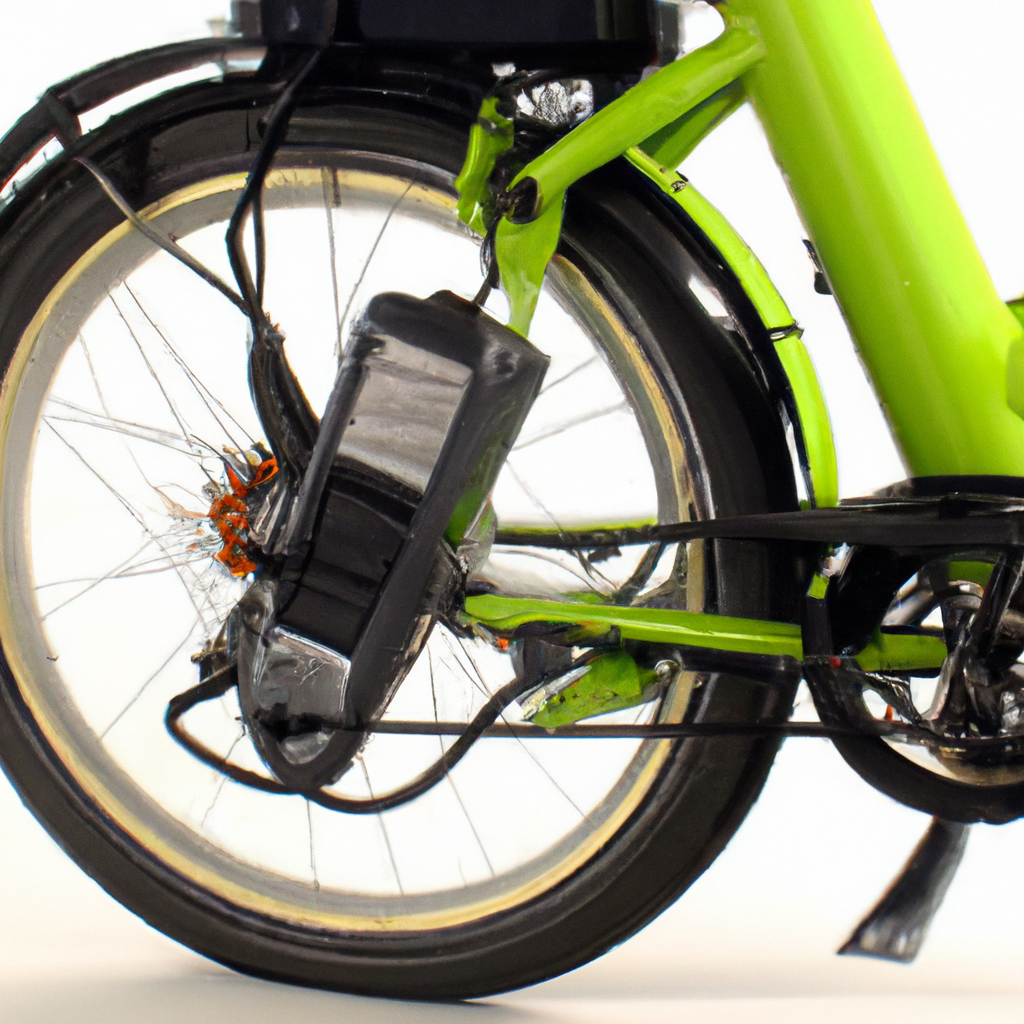Are you considering purchasing an electric bike but have some doubts and concerns? Look no further! In this informative article, we aim to clear up common misconceptions about electric bikes, providing you with the knowledge and confidence you need to make an informed decision. Whether you’re planning to ride in the city or venture off-road, our beginner-friendly tips and step-by-step guides will help you navigate the world of electric biking effortlessly. Say goodbye to doubts and hello to your new e-bike adventure!
Myth 1: Electric bikes are just like motorcycles
Electric bikes are not the same as motorcycles
Contrary to popular belief, electric bikes are not the same as motorcycles. While they share some similarities, there are key differences between the two. Electric bikes, also known as e-bikes, are bicycles with an integrated electric motor that provides assistance while pedaling. On the other hand, motorcycles are motorized vehicles that rely solely on their engines for propulsion.
Electric bikes have limited speed and power compared to motorcycles
One common misconception is that electric bikes are as fast and powerful as motorcycles. However, this is not the case. In most countries, electric bikes have a speed limit of 20 to 28 mph (32 to 45 km/h), depending on local regulations. Additionally, electric bikes usually have motors with a power output of up to 750 watts, which is significantly lower than the power output of motorcycles. This limited speed and power ensure that electric bikes remain within the category of bicycles, making them safer and more accessible for a wider range of riders.
Electric bikes require pedaling to engage the motor
Unlike motorcycles that rely solely on their engines, electric bikes require pedaling in order to engage the motor. The electric motor on an e-bike provides assistance to the rider’s pedaling efforts, making cycling easier and more efficient. This means that the rider still needs to put in physical effort to ride an electric bike, just like with a regular bicycle. The motor amplifies the rider’s pedaling power, allowing them to travel at higher speeds and tackle challenging terrains with less effort.
Electric bikes are much quieter than motorcycles
Another misconception is that electric bikes are just as noisy as motorcycles. In reality, electric bikes are significantly quieter. The absence of a combustion engine in electric bikes eliminates the loud noise that is typically associated with motorcycles. The silent operation of electric bikes not only reduces noise pollution but also allows riders to enjoy a more peaceful and serene riding experience. This makes electric bikes particularly suitable for urban environments where noise levels can be a concern.
Myth 2: Electric bikes are too expensive
Electric bikes have a wide price range, including affordable options
While it is true that some electric bikes can be quite expensive, it is important to note that there is a wide price range to choose from, including more affordable options. Electric bikes come in various models and configurations, each with its own set of features and price points. Entry-level electric bikes can start at around $500, offering basic functionality and performance. As you move up in price range, you can find electric bikes with higher specifications, improved components, and enhanced features.
Electric bikes have lower maintenance and operating costs compared to cars or motorcycles
When considering the cost of owning an electric bike, it’s essential to compare it to the cost of other modes of transportation. Unlike cars or motorcycles, electric bikes have lower maintenance and operating costs. Electric bikes do not require regular fueling, as they can be charged using electricity from a standard power outlet. Additionally, the maintenance required for electric bikes is minimal compared to that of motorized vehicles. With fewer moving parts and less wear and tear, electric bikes can provide significant cost savings in the long run.
Electric bike subsidies and incentives are available in some locations
In addition to the lower maintenance and operating costs, there are also subsidies and incentives available for electric bikes in certain locations. Some governments and municipalities offer financial incentives, tax credits, or rebates to encourage the adoption of electric bikes as a sustainable mode of transportation. These incentives can help offset the initial cost of purchasing an electric bike, making them even more affordable and accessible. It is worth exploring the incentives and subsidies available in your area to take advantage of these cost-saving opportunities.

Myth 3: Electric bikes are cheating
Electric bikes still require physical effort from the rider
One of the most common myths about electric bikes is that they are a form of cheating because they provide motorized assistance. However, it’s important to understand that electric bikes still require physical effort from the rider. The electric motor on an e-bike simply amplifies the rider’s pedaling efforts, making it easier to ride and allowing for longer distances and steeper climbs. The rider still needs to put in the effort to pedal, albeit with added assistance from the motor.
Electric bikes provide assistance, not complete propulsion
Contrary to the notion of cheating, electric bikes provide assistance rather than complete propulsion. The electric motor on an e-bike does not replace the need for pedaling but rather augments it. The level of assistance can be adjusted based on the rider’s preference and the terrain. This means that riders can choose to use less assistance and put in more physical effort, or increase the assistance to make their ride more comfortable. The choice is entirely up to the rider, allowing for a personalized and enjoyable riding experience.
Electric bikes can be adjusted to different assist levels
To cater to a wide range of riders and riding preferences, electric bikes are equipped with different assist levels. These assist levels determine the amount of motorized assistance provided while pedaling. Riders can select from multiple options, such as eco mode for lower assistance and maximum range, or sport mode for higher assistance and increased speed. The ability to adjust the assist levels allows riders to customize their electric bike experience according to their fitness level, desired effort level, or specific terrain conditions.
Electric bikes promote physical activity and exercise
Contrary to the belief that electric bikes discourage physical activity, they actually promote exercise and physical well-being. By offering assistance while pedaling, electric bikes make cycling more accessible to a wider range of individuals, including those who may not have the physical fitness or stamina to ride a traditional bicycle over long distances or challenging terrains. Electric bikes encourage people to get outdoors, be active, and reap the numerous health benefits associated with regular exercise.
Myth 4: Electric bikes have limited range
Electric bikes have improved battery technology and longer ranges
In the early days of electric bikes, limited range was a valid concern. However, with advancements in battery technology, modern electric bikes now offer longer ranges. Lithium-ion batteries, commonly used in electric bikes, have improved energy density, allowing for increased power and longer-lasting charges. Depending on factors such as terrain, rider weight, assist level, and battery capacity, electric bikes can now achieve ranges of up to 80 miles (130 kilometers) on a single charge.
Range depends on various factors, including terrain, rider weight, and assist level
It is important to note that the range of an electric bike can vary based on several factors. Terrain plays a significant role, as climbing steep hills requires more power and can drain the battery faster. Rider weight also affects range, as carrying heavier loads will require more energy. Additionally, the chosen assist level will impact the range, as higher assistance levels consume more battery power. Despite these variables, electric bikes offer a range that is suitable for most daily commuting needs and recreational rides.
Charging infrastructure is expanding, allowing for longer trips
To address concerns about range and charging, the infrastructure for charging electric bikes is expanding. Many cities and public spaces now offer dedicated charging stations for electric bikes, making it more convenient for riders to top up their batteries while on the go. Moreover, advancements in charging technology have led to faster charging times, reducing the wait time for recharging. As the charging infrastructure continues to develop, riders can expect even greater convenience and flexibility in planning longer trips on their electric bikes.

Myth 5: Electric bikes are heavy and cumbersome
Electric bikes come in various weights, including lightweight options
While it is true that some electric bikes can be heavier than traditional bicycles, it is important to note that electric bikes come in various weights, including lightweight options. Manufacturers have made significant advancements in electric bike design, utilizing lightweight materials such as aluminum or carbon fiber to reduce the overall weight of the bike. Lightweight electric bikes are easier to maneuver, provide a more agile riding experience, and are suitable for riders who may have concerns about the weight of the bike.
Advancements in technology have made electric bikes lighter and more compact
Advancements in technology have played a crucial role in making electric bikes lighter and more compact. The integration of compact and efficient electric motors, along with lightweight batteries, has significantly reduced the overall weight of electric bikes without compromising performance or range. These advancements have made electric bikes more comparable in weight to traditional bicycles, ensuring that riders can enjoy the benefits of electric assistance without feeling burdened by the weight of the bike.
Electric bikes are designed for easy maneuverability
Contrary to the belief that electric bikes are cumbersome, they are actually designed with maneuverability in mind. Electric bike frames are often built with considerations for balance, stability, and agility, allowing riders to easily navigate through urban environments or tackle off-road trails. The weight distribution and geometry of electric bikes are optimized to provide a comfortable and responsive ride, enabling riders to enjoy the benefits of electric assistance without sacrificing maneuverability.
Myth 6: Electric bikes are not environmentally friendly
Electric bikes produce fewer emissions compared to cars or motorcycles
One of the key advantages of electric bikes is their environmental friendliness. Compared to cars or motorcycles, electric bikes produce significantly fewer emissions. Electric bikes run on electricity, which can be sourced from renewable energy sources such as wind or solar power. By replacing short car trips with electric bike rides, individuals can contribute to reducing air pollution and carbon emissions, making a positive impact on the environment.
Electric bikes can be charged using renewable energy sources
Another environmental benefit of electric bikes is that they can be charged using renewable energy sources. As the demand for sustainable energy continues to grow, more renewable energy options are becoming available. Riders have the option to charge their electric bikes using electricity generated from renewable sources, such as solar panels or wind turbines. By opting for renewable energy charging options, electric bike riders can further reduce their carbon footprint and make a positive contribution to combating climate change.
Electric bikes reduce traffic congestion and parking issues
Electric bikes can also help address the issue of traffic congestion and parking limitations in urban areas. By encouraging more people to use electric bikes for short trips and commuting, the number of cars on the road can be reduced. This reduces overall traffic congestion, making transportation more efficient for everyone. Additionally, electric bikes require less parking space compared to cars, alleviating the stress of finding parking spots in crowded areas. Their compact size and ability to navigate through traffic make electric bikes a convenient and sustainable alternative for urban mobility.

Myth 7: Electric bikes are unreliable
Electric bikes are built with reliable components
Contrary to the belief that electric bikes are unreliable, they are built with reliable components. Reputable electric bike manufacturers use high-quality materials and components to ensure the durability and longevity of their products. The electrical systems, motors, and batteries are designed to withstand the rigors of daily use and provide reliable performance. With proper maintenance and care, electric bikes can provide many years of trouble-free riding.
Regular maintenance ensures optimal performance and longevity
Like any mode of transportation, electric bikes require regular maintenance to ensure optimal performance and longevity. This includes routine checks and adjustments to ensure that all components are functioning properly. It is important to follow the manufacturer’s guidelines for maintenance, including inspections, lubrication, and cleaning. By staying on top of regular maintenance, riders can ensure that their electric bikes remain reliable and continue to provide smooth and efficient rides.
Reputable electric bike brands offer warranties and customer support
To provide peace of mind to riders, reputable electric bike brands often offer warranties and customer support. These warranties cover manufacturing defects and provide assistance in case of any issues or concerns regarding the electric bike. In addition, customer support teams are available to answer questions, provide technical assistance, and offer guidance on maintenance and troubleshooting. By choosing electric bikes from reputable brands, riders can have confidence in the reliability and support provided by the manufacturer.
Myth 8: Electric bikes are difficult to ride
Electric bikes have intuitive controls and are easy to operate
Contrary to the belief that electric bikes are difficult to ride, they are actually designed to be user-friendly and easy to operate. Electric bikes feature intuitive controls, typically located on the handlebars, allowing riders to effortlessly adjust the assist level or activate the motor. The controls are easily accessible and require minimal effort to operate, ensuring a seamless and enjoyable riding experience for riders of all skill levels.
Basic cycling skills are sufficient for riding an electric bike
No special or advanced skills are required to ride an electric bike. Basic cycling skills, such as balancing, pedaling, and steering, are sufficient to operate an electric bike effectively. The electric assistance provided by the motor makes it easier for riders to maintain balance and control, especially during starts and stops or when navigating through traffic. This makes electric bikes accessible to a wide range of individuals, regardless of their previous cycling experience or skill level.
Practice and familiarity will increase confidence and proficiency
As with any new activity, practice and familiarity will increase confidence and proficiency when riding an electric bike. It is natural to take some time to adapt to the added assistance and adjust to the different dynamics of an electric bike. By gradually increasing ride distances and exploring various terrains, riders can gain a better understanding of their electric bike’s capabilities and become more comfortable and proficient in handling it. Through experience, riders will develop a natural sense of control and confidence, making riding an electric bike an enjoyable and effortless experience.

Myth 9: Electric bikes are only for the elderly or unfit
Electric bikes cater to a wide range of riders, including the young and fit
One common misconception is that electric bikes are only suitable for the elderly or unfit individuals. However, electric bikes cater to a wide range of riders, including the young and fit. Electric bikes provide an opportunity for individuals who may not have the physical fitness or stamina to ride a traditional bicycle over long distances. They also cater to riders who may have joint issues or other physical limitations, allowing them to enjoy the benefits of cycling and explore new territories that were previously inaccessible.
Electric bikes allow riders to go further and tackle challenging terrains
Electric bikes empower riders to go further and tackle challenging terrains that may have been otherwise daunting. With the assistance of the electric motor, riders can cover longer distances and navigate steep inclines with greater ease. This opens up a whole new world of exploration and adventure, as riders can embark on longer rides and discover places they may have never thought possible. Electric bikes are not limited to flat and easy routes – they provide the confidence and ability to conquer more demanding terrains.
Electric bikes can be enjoyed by anyone, regardless of age or fitness level
One of the greatest advantages of electric bikes is their inclusivity. Electric bikes can be enjoyed by anyone, regardless of age or fitness level. They provide an opportunity for individuals of all ages to engage in physical activity and experience the joy of cycling. Whether it’s commuting to work, running errands, or enjoying leisurely rides, electric bikes offer a versatile and accessible mode of transportation and recreation. Riders can adjust the level of assistance to suit their specific needs and abilities, ensuring that everyone can participate and benefit from electric biking.
Myth 10: Electric bikes are a passing trend
Electric bikes have gained significant popularity worldwide
Contrary to the belief that electric bikes are a passing trend, they have gained significant popularity worldwide. The demand for electric bikes has been steadily increasing, with more and more individuals recognizing the numerous benefits they offer. Electric bikes have become a mainstream mode of transportation and recreation in many cities and countries around the globe. This surge in popularity is a testament to the effectiveness and relevance of electric bikes as a sustainable and practical solution for modern mobility needs.
Growing awareness of sustainability and health benefits will continue to drive demand
As the awareness of sustainability and health benefits continues to grow, the demand for electric bikes is expected to increase even further. Many individuals are seeking alternative modes of transportation that reduce their carbon footprint and promote a healthier lifestyle. Electric bikes perfectly align with these aspirations, offering a sustainable and physically active way of getting around. The growing emphasis on environmental consciousness and personal well-being will continue to drive the demand for electric bikes in the long term.
Electric bikes are subject to ongoing technological advancements
Electric bikes are not just a passing trend, but rather a product of ongoing technological advancements. As electric bike technology continues to evolve, we can expect even more innovative features and improvements. Manufacturers are constantly refining their designs, integrating new components, and enhancing performance. From advancements in battery efficiency and range to improvements in motor power and control systems, electric bikes will continue to benefit from ongoing research and development. This ensures that electric bikes remain at the forefront of sustainable and efficient transportation options.
In conclusion, it is important to debunk the common myths surrounding electric bikes to provide accurate information and promote their benefits. Electric bikes are not just like motorcycles, as they have limited speed and require pedaling to engage the motor. They are not excessively expensive, as there is a wide range of prices available, lower maintenance costs, and subsidies or incentives in some areas. Electric bikes are not cheating, as they still require physical effort, provide assistance instead of complete propulsion, and promote physical activity. Range limitations can be overcome with improved battery technology and expanding charging infrastructure. Electric bikes are not heavy and cumbersome, as they come in various weights, advancements in technology have made them lighter, and they are designed for easy maneuverability. Electric bikes are environmentally friendly, produce fewer emissions, can be charged using renewable energy sources, and reduce traffic congestion. They are not unreliable, as they are built with reliable components, require regular maintenance, and reputable brands offer warranties and customer support. Electric bikes are not difficult to ride, as they have intuitive controls, basic cycling skills are sufficient, and practice increases confidence and proficiency. Electric bikes are not only for the elderly or unfit, as they cater to a wide range of riders, allow tackling challenging terrains, and can be enjoyed by anyone. Electric bikes are not a passing trend, as they have gained popularity worldwide, and the growing awareness of sustainability and health benefits will continue to drive demand. Lastly, electric bikes are subject to ongoing technological advancements, ensuring their relevance and effectiveness in the future.




